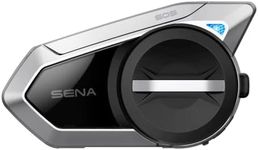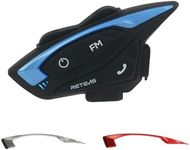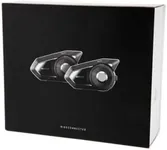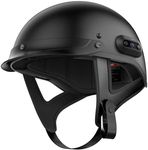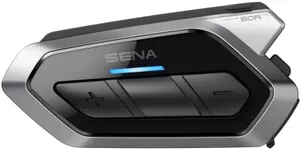Buying Guide for the Best Motorcycle Communication Systems
Choosing the right motorcycle communication system can significantly enhance your riding experience, whether you're riding solo or with a group. These systems allow you to stay connected with fellow riders, navigate easily, listen to music, and even take calls without compromising safety. To make an informed decision, it's essential to understand the key specifications and how they align with your needs.RangeRange refers to the maximum distance over which the communication system can maintain a connection between riders. This is crucial for group rides where riders may spread out over a distance. Short-range systems (up to 500 meters) are suitable for close-knit riding groups, while medium-range systems (up to 1 kilometer) offer more flexibility. Long-range systems (over 1 kilometer) are ideal for large groups or open-road touring. Consider your typical riding environment and group size when choosing the range.
Battery LifeBattery life indicates how long the communication system can operate on a single charge. This is important for ensuring that your device lasts throughout your ride. Systems with shorter battery life (up to 8 hours) are fine for short trips, while medium battery life (8-12 hours) suits day-long rides. Long battery life (over 12 hours) is essential for multi-day tours or extended use. Think about the duration of your rides and how often you can recharge the device.
Number of ConnectionsThis spec tells you how many riders can be connected simultaneously. It's important for group communication. Systems that support 2-4 connections are good for small groups, while those supporting 5-8 connections are better for medium-sized groups. For large groups, look for systems that can handle 9 or more connections. Consider the size of your riding group and how often you ride with others.
Audio QualityAudio quality determines how clear the sound is during communication. This is vital for understanding conversations, especially at high speeds. Basic systems offer standard audio quality, which is sufficient for casual use. Mid-range systems provide enhanced audio with noise cancellation, suitable for regular riders. High-end systems offer superior audio clarity and advanced noise reduction, ideal for professional riders or those who prioritize sound quality. Think about how important clear communication is for your rides.
Ease of UseEase of use refers to how simple it is to operate the communication system while riding. This includes the design of the controls, voice command capabilities, and overall user interface. Basic systems may have manual controls that require more attention, suitable for occasional use. Mid-range systems offer a balance of manual and voice controls, ideal for regular riders. High-end systems feature intuitive interfaces and advanced voice commands, perfect for those who need hands-free operation. Consider how comfortable you are with technology and how much attention you can spare while riding.
CompatibilityCompatibility indicates whether the communication system can connect with other brands and devices. This is important if you ride with others who may have different systems. Basic systems may only connect with the same brand, suitable for solo riders or small groups with the same equipment. Mid-range systems offer some cross-brand compatibility, ideal for mixed-brand groups. High-end systems provide extensive compatibility with various brands and devices, perfect for diverse riding groups. Think about who you ride with and the equipment they use.
Weather ResistanceWeather resistance refers to the system's ability to withstand different weather conditions, such as rain, dust, and extreme temperatures. This is crucial for ensuring durability and consistent performance. Basic systems may offer minimal weather resistance, suitable for fair-weather riders. Mid-range systems provide moderate resistance, ideal for regular riders who encounter occasional bad weather. High-end systems offer robust weatherproofing, perfect for all-weather riders or those who ride in harsh conditions. Consider the typical weather conditions you ride in.





